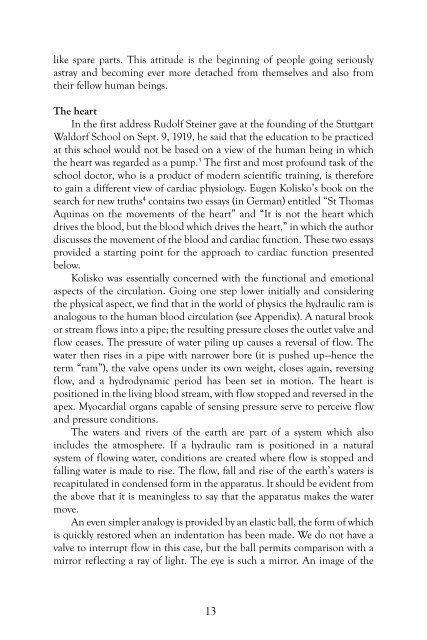When Healing Becomes Educating, Vol. 6 - Waldorf Research Institute
When Healing Becomes Educating, Vol. 6 - Waldorf Research Institute
When Healing Becomes Educating, Vol. 6 - Waldorf Research Institute
You also want an ePaper? Increase the reach of your titles
YUMPU automatically turns print PDFs into web optimized ePapers that Google loves.
like spare parts. This attitude is the beginning of people going seriously<br />
astray and becoming ever more detached from themselves and also from<br />
their fellow human beings.<br />
The heart<br />
In the first address Rudolf Steiner gave at the founding of the Stuttgart<br />
<strong>Waldorf</strong> School on Sept. 9, 1919, he said that the education to be practiced<br />
at this school would not be based on a view of the human being in which<br />
the heart was regarded as a pump. 3 The first and most profound task of the<br />
school doctor, who is a product of modern scientific training, is therefore<br />
to gain a different view of cardiac physiology. Eugen Kolisko’s book on the<br />
search for new truths 4 contains two essays (in German) entitled “St Thomas<br />
Aquinas on the movements of the heart” and “It is not the heart which<br />
drives the blood, but the blood which drives the heart,” in which the author<br />
discusses the movement of the blood and cardiac function. These two essays<br />
provided a starting point for the approach to cardiac function presented<br />
below.<br />
Kolisko was essentially concerned with the functional and emotional<br />
aspects of the circulation. Going one step lower initially and considering<br />
the physical aspect, we find that in the world of physics the hydraulic ram is<br />
analogous to the human blood circulation (see Appendix). A natural brook<br />
or stream flows into a pipe; the resulting pressure closes the outlet valve and<br />
flow ceases. The pressure of water piling up causes a reversal of flow. The<br />
water then rises in a pipe with narrower bore (it is pushed up—hence the<br />
term “ram”), the valve opens under its own weight, closes again, reversing<br />
flow, and a hydrodynamic period has been set in motion. The heart is<br />
positioned in the living blood stream, with flow stopped and reversed in the<br />
apex. Myocardial organs capable of sensing pressure serve to perceive flow<br />
and pressure conditions.<br />
The waters and rivers of the earth are part of a system which also<br />
includes the atmosphere. If a hydraulic ram is positioned in a natural<br />
system of flowing water, conditions are created where flow is stopped and<br />
falling water is made to rise. The flow, fall and rise of the earth’s waters is<br />
recapitulated in condensed form in the apparatus. It should be evident from<br />
the above that it is meaningless to say that the apparatus makes the water<br />
move.<br />
An even simpler analogy is provided by an elastic ball, the form of which<br />
is quickly restored when an indentation has been made. We do not have a<br />
valve to interrupt flow in this case, but the ball permits comparison with a<br />
mirror reflecting a ray of light. The eye is such a mirror. An image of the<br />
13

















